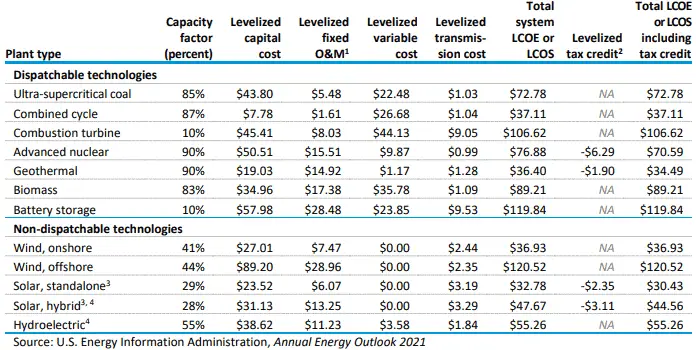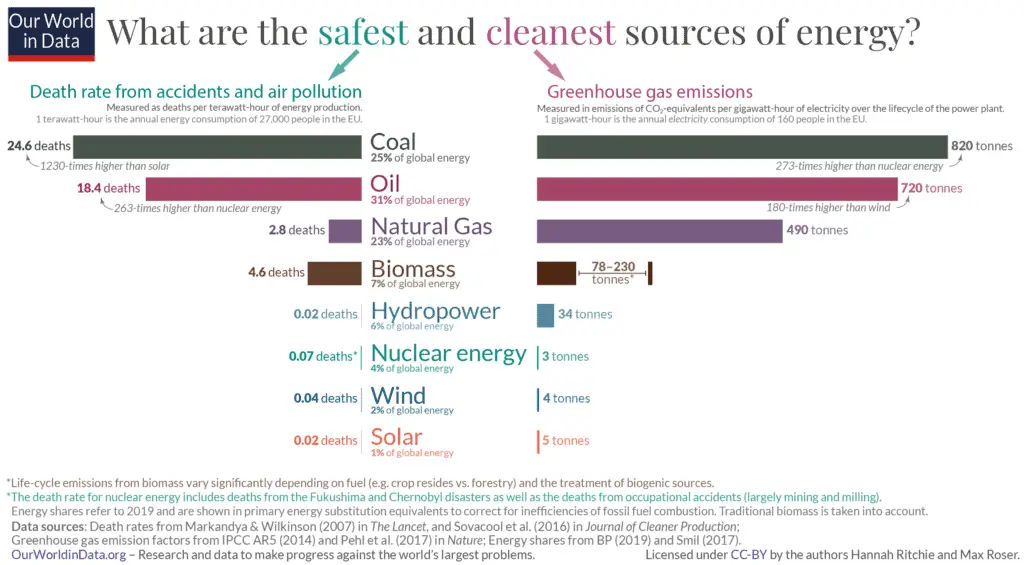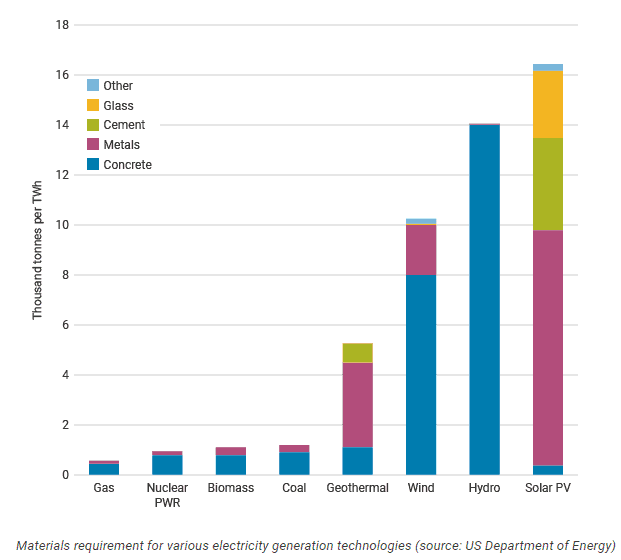Future of Nuclear Energy
A big share of nuclear, a big share of renewables, and some storage are the best mix that is low-carbon, reliable, and at the lowest cost. Without nuclear, demands on the overcapacity of renewables, transmission system, and energy storage systems would result in excessive use of land and resources.
Future Costs: Opportunities exist to significantly reduce the capital cost and shorten the construction schedule for new nuclear power plants.
Safety: Based on the entire life cycle, fossil fuels are the most dangerous, while nuclear and modern renewable energy sources are vastly safer and cleaner.
Sustainability: Nuclear energy is one of the few sustainable primary sources. It is the only controllable large-scale source that could complement variable renewable sources (wind and solar power) and that could ensure reliable 24/7 energy.
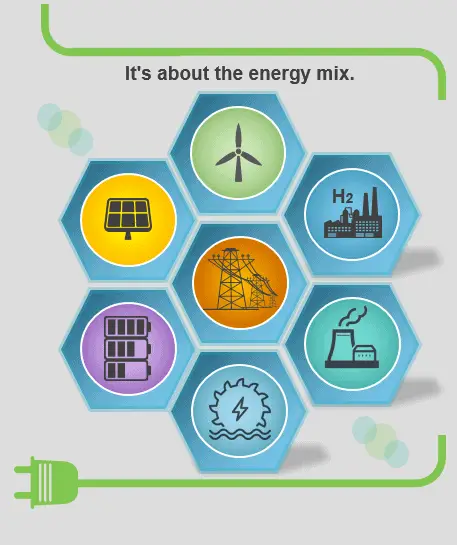 In the 21st century, the world faces the new challenge of drastically reducing emissions of greenhouse gases while simultaneously expanding energy access and economic opportunity to billions of people. Global energy demand is growing, which puts upward pressure on energy prices. It is obvious; renewables have an irreplaceable role. While various low-carbon technologies can be employed in various combinations, the MIT analysis shows the potential contribution nuclear can make as a dispatchable low-carbon technology. Without that contribution, the cost of achieving deep decarbonization targets increases significantly.
In the 21st century, the world faces the new challenge of drastically reducing emissions of greenhouse gases while simultaneously expanding energy access and economic opportunity to billions of people. Global energy demand is growing, which puts upward pressure on energy prices. It is obvious; renewables have an irreplaceable role. While various low-carbon technologies can be employed in various combinations, the MIT analysis shows the potential contribution nuclear can make as a dispatchable low-carbon technology. Without that contribution, the cost of achieving deep decarbonization targets increases significantly.
See also: Brook Barry W (2012). “Could nuclear fission energy, etc., solve the greenhouse problem? The affirmative case”.
About 50% of all global energy, including synthetic fuels, etc., could be generated within approximately 30 years if the global nuclear fission build rate was identical to historical proven installation rates calculated in GW per year per unit of global GDP (GW/year/$). This is the proven rate at which nuclear energy was added in France and Sweden during their building programs in the 1980s. This contrasts the conceptual studies for 100% renewable energy systems, which would require an order of magnitude more costly global investment per year and has no historical precedent. The nuclear power debate concerns the controversy surrounding deploying and using nuclear fission reactors to generate electricity from nuclear fuel for civilian purposes.
Source: MIT, The Future of Nuclear Energy in a Carbon-Constrained World
Costs of Nuclear Energy
Opportunities exist to significantly reduce the capital cost and shorten the construction schedule for new nuclear power plants.
Nuclear power plant construction is typical of large infrastructure projects worldwide, whose costs and delivery challenges tend to be underestimated. These new builds require significant upfront investments, which were mostly caused by highly customized designs of large plants but can be driven down by standardized, reusable designs.
The basic economics metric for any generating plant is the levelized cost of electricity (LCOE). The total cost to build and operate a power plant over its lifetime is divided by the total electricity output dispatched from the plant over that period, typically the cost per megawatt-hour. It takes into account the financing costs of the capital component.
Over the last decade, the LCOE (levelized cost of electricity) of renewable sources, especially solar power, has fallen sharply. This is quite logical; renewables are now being applied globally, so the savings from mass production are being applied. While new nuclear power plants are more expensive than new renewable energy in upfront investment, the latter’s cost is expected to grow as the grid is saturated with intermittent sources and energy storage, and land usage becomes a primary barrier to their expansion. Note that life-cycle land usage by nuclear power (including mining and waste storage, direct and indirect) is 100 m2/GWh which is ½ of solar power and 1/10 of wind power.
In contrast, the LCOE of nuclear energy has been growing. This is also logical, the majority of nuclear plants today are approaching the end of their design life, and only a few have been built in the last 20 years. At present, nuclear energy has been declining for thirty years, and educational capacities and supply chains are in line with this. Opportunities exist to significantly reduce the capital cost and shorten the construction schedule for new nuclear power plants. First, deploying multiple standardized units, especially at a single site, affords considerable learning from the construction of each unit.
Safety of Nuclear Energy
Safety: Based on the entire life cycle, fossil fuels are the most dangerous, while nuclear and modern renewable energy sources are vastly safer and cleaner.
We realize that the term “nuclear” often evokes a feeling of something negative or even dangerous. We do not claim this or that opinion is the only correct opinion. But it is noteworthy that most nuclear engineers, people who know what nuclear means, do not connect the term “nuclear” with anything negative or dangerous.
There are many sources of energy. Wind, solar, power, oil, natural gas, coal, petroleum, and biofuels all provide electricity and energy for the world. All these energy sources have negative effects and can cause human injury or even death. But they differ enormously in size. There is much debate over which form of energy is the safest. You may be surprised, but:
Based on the entire life cycle, fossil fuels are the most dangerous, while nuclear and modern renewable energy sources are vastly safer and cleaner.
Why? Because such considerations need to include all aspects of resource use, such as mining, processing, material transportation, air pollution, and possible accidents. But while energy from fossil fuels brings many benefits, it unfortunately also has major negative consequences. There are three main categories of negative consequences.
- Air pollution. According to WHO, air pollution kills an estimated seven million people worldwide every year. From smog hanging over cities to smoke inside the home, air pollution poses a major threat to health and climate.
- Accidents. This includes accidents in the mining and extraction of fuels (coal, uranium, rare metals, oil, and gas) and accidents that occur in transporting raw materials and infrastructure.
- Greenhouse gas emissions.
Many studies point to the safety and usability of nuclear power. Nuclear power is comparable to, and in some cases lower, than many renewable energy sources in terms of lives lost in the past per unit of electricity delivered.
In nuclear energy, society is most concerned about nuclear safety. For nuclear power plants, perfect safety cannot be guaranteed. That is a fact. It is also a fact that the safety of nuclear power plants. Today is an important engineering field that has absolute priority at a nuclear power plant. Most nuclear power plants introduce a ‘defense-in-depth ‘approach to achieve maximum safety. This approach comprises multiple safety systems supplementing the natural features of the reactor core. The level of safety of existing nuclear power plants is very high. Nuclear power plants regularly undergo independent inspections by various international organizations, such as the IAEA and WANO. The level of cooperation is also very high. Although the power plants are owned by competing companies, there is a maximum exchange of all information in the field of nuclear safety.
See also: Fear of Radiation – Is it rational?
Finally, humans are often inconsistent in our treatment of perceived risks. Even though two situations may have similar risks, people will find one situation permissible and another unjustifiably dangerous. What about risks that arise from transportation? Nearly 1.25 million people die in road crashes each year, on average, 3,287 deaths a day. Road crashes are the leading cause of death among young people ages 15-29 and the second leading cause of death worldwide among young people ages 5-14. On the road, people don’t realize the kinetic energy of a car.
We must add no industry is immune from accidents, but all industries learn from them. Major accidents have also led to safety improvements in the chemical and oil-gas industries. There is a wide public acceptance that the risks associated with these industries are an acceptable trade-off for our dependence on their products and services. In reality, the safety record of nuclear power plants, by comparison with other electricity generation sources, is very good. The use of nuclear energy for electricity generation can be considered extremely safe. Several thousand people die in coal mines to provide this widely used fuel for electricity every year. There are also significant health and environmental effects arising from fossil fuel use.
It’s all about what risks we want and has to accept. But note that the electric power industry represents a vital national interest. Electric power has become a central component of what has come to be known as critical infrastructure. Because electric power is the keystone of all critical infrastructures, it must be made as secure as possible. Any massive failure of the electric power industry would have immediate consequences in the physical, economic, and political realms. This ability to impact all three realms makes the electric power industry unique among infrastructures, as it has all three as immediate consequences. We will not claim that electricity generation helps save lives, but it can be argued that blackouts can take lives.
Sustainability of Nuclear Energy
Nuclear energy is one of the few sustainable primary sources. It is the only controllable large-scale source that could complement variable renewable sources (wind and solar power) and that could ensure reliable 24/7 energy.
What do renewable and sustainable mean in the energy world? These terms are not the same. Not everything renewable is sustainable; in turn, not everything sustainable is necessarily renewable.
Sustainability is the capacity to endure relatively continuously across various domains of life. Sustainability is defined in the context of human civilization as the practical ability to meet today’s basic needs without compromising future generations‘ ability to meet their basic needs and maintain their standard of living.
Sustainability is not possible if human society:
- extracts and disperses substances faster than they return to the earth’s crust (e.g., oil, coal, metals, etc.)
- depletes and degrades resources faster than they are regenerated and progressively destroys ecosystems (e.g., deforestation, overfishing, and excessive land use)
- it is not able to radically limit or stop exponential population growth
The first two points directly concern energy uses. Sustainable energy uses energy sources that will not be depleted in the time frame relevant to humanity and that ensure the ability of biological systems to maintain diversity and productivity indefinitely. To some extent, it means the use of renewable energy sources. But even a renewable energy resource becomes unsustainable whenever used faster than regenerates or when its use depletes and degrades other resources. Some renewable energy projects, such as clearing forests to produce biofuels, can cause severe environmental damage. Also, the problem with wind and especially solar power is that supply does not correspond with demand. In other words, the highest energy consumption for most countries is in autumn and winter, when there is little wind inland and little sun. The higher the share of these sources in the energy mix, the higher the demands on the overcapacity, transmission system, and energy storage systems, which results in excessive use of land and materials (lithium, rare-earth metals, etc.). Renewables tend to make very large demands on resources to construct the plant used for harnessing the natural energy – per kilowatt-hour produced, much more than nuclear power. Wind turbine plants need over ten times the amount of steel, 15 times the amount of copper, and more than twice the amount of other critical minerals than nuclear power per kWh output.
Conversely, a non-renewable resource can be sustainable if used at a slow enough rate that supplies last for thousands of years, and the environmental impacts don’t cause huge problems. This is most obvious with respect to nuclear power. The world’s present measured resources of uranium (6.1 Mt) in the cost category are less than three times present spot prices and used only in conventional reactors are enough to last for about 90 years. But this time does not include the following aspects:
- Proven resources. Like fossil fuels, the amount of uranium available from conventional sources has long been underestimated, and reserves are only calculated for economically recoverable sources using present-day technologies and pricing.
- Fuel recycling. The removed fuel (spent nuclear fuel) still contains about 96% of reusable material (must be removed due to decreasing kinf of an assembly). Fuel reprocessing promises to save fresh fuel by order of magnitude. Today, the cost of uranium is a small percentage of the cost of nuclear fuel, which is itself a small percentage of the cost of nuclear power. Therefore, plant operators are not motivated to reprocess fuel.
- Advanced reactors and thorium reactors. Advanced fast reactors generally have an excess of neutrons (due to low parasitic absorption). These neutrons given off by fission reactions can “breed” more fuel from otherwise non-fissionable isotopes or be used for other purposes. The term “breeder” refers to the types of configurations which can be the breeding ratio higher than 1. That means such reactors produce more fissionable fuel than they consume. Today uranium is the only fuel supply for nuclear reactors. However, thorium can also be utilized as fuel for CANDU reactors or in reactors specially designed for this purpose.
- Unconventional resources. The main unconventional resource for uranium is rock phosphate. Uranium is also naturally present in seawater at a concentration of about 3 micrograms per liter, with 4.4 billion tons of uranium considered present in seawater at any time. In 2014 it was suggested that it would be economically competitive to produce nuclear fuel from seawater if the process was implemented on a large scale.
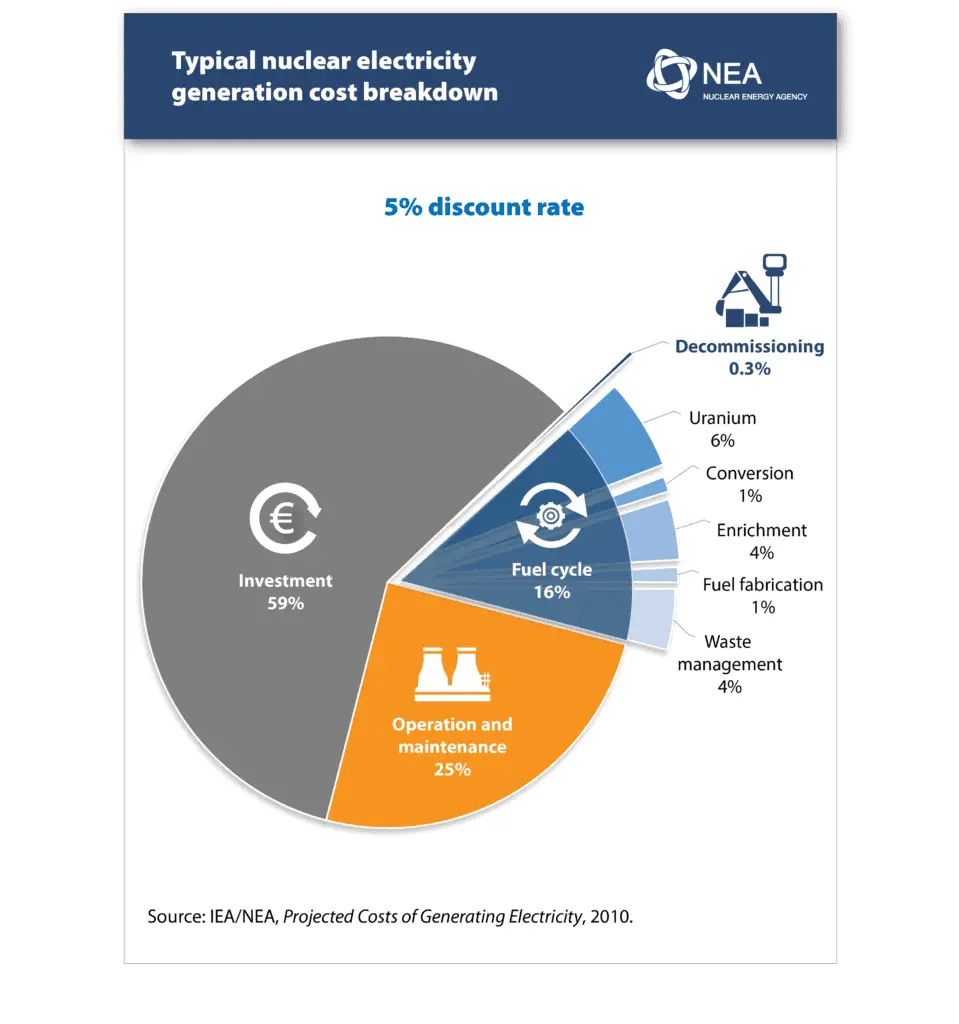 Some commentators have argued that these facts strengthen the case for nuclear power to be considered renewable energy. We do not claim, and it will be simple. Light water reactors make relatively inefficient use of nuclear fuel, mostly using only the rare uranium-235 isotope. The scarcity of uranium-235 makes current nuclear power unsustainable. But as you can see, there are a lot of cost-effective options. We must note that nuclear electricity prices are relatively insensitive to the price of uranium. For nuclear power plants, busbar costs are dominated by capital costs, which can make up more than 60 percent of the LCOE. On the other hand, fuel costs are a relatively small factor in a nuclear plant’s LCOE (less than 20 percent). As a result, the cost of electricity from a nuclear plant is sensitive to construction costs and interest rates but relatively insensitive to the price of uranium, which accounts for only 6% of the total LCOE.
Some commentators have argued that these facts strengthen the case for nuclear power to be considered renewable energy. We do not claim, and it will be simple. Light water reactors make relatively inefficient use of nuclear fuel, mostly using only the rare uranium-235 isotope. The scarcity of uranium-235 makes current nuclear power unsustainable. But as you can see, there are a lot of cost-effective options. We must note that nuclear electricity prices are relatively insensitive to the price of uranium. For nuclear power plants, busbar costs are dominated by capital costs, which can make up more than 60 percent of the LCOE. On the other hand, fuel costs are a relatively small factor in a nuclear plant’s LCOE (less than 20 percent). As a result, the cost of electricity from a nuclear plant is sensitive to construction costs and interest rates but relatively insensitive to the price of uranium, which accounts for only 6% of the total LCOE.
The MIT report found that the most cost-efficient, reliable grid will come from an energy mix in the next decade.
Source: MIT, The Future of Nuclear Energy in a Carbon-Constrained World
And what about radioactive waste?
Radioactive waste comes from many sources. Radioactive (or nuclear) waste is a byproduct for nuclear reactors, fuel processing plants, hospitals, various industrial applications, and research facilities. Radioactive waste is also naturally occurring radioactive materials (NORM) that can be concentrated due to the processing or consumption of coal, oil, gas, and some minerals.
The world’s nuclear fleet creates about 10,000 metric tons of high-level spent nuclear fuel each year. But each plant operator provides for waste management, disposal, and decommissioning costs in the actual cost of electricity (i.e., it has internalized them) to minimize external costs. Unlike nuclear energy, some energy sources dispose of wastes to the environment or have health effects that are not costed into the product. Their quantification is necessary to enable rational choices between energy sources.
There are many pervasive myths regarding both radiation and radioactive waste. These are described by WNA in the article: Radioactive Waste – Myths and Realities
This is not true. The nuclear industry has developed – and implemented – most of the necessary technologies required for the final disposal of all of the waste it produces. The remaining issue is one of public acceptance and not of technological feasibility. The safe, environmentally-sound disposal of HLW is technologically proven, with the international scientific consensus on deep geological repositories.
Moreover, fuel reprocessing and advanced nuclear technologies can significantly reduce the amount of present and future high-level waste. The closed fuel cycle is an advanced fuel cycle whose purpose is to achieve nuclear power sustainability by further reducing the radiotoxicity of the final waste and improving resource utilization while maintaining its economic viability. There are currently different types of advanced fuel cycles under research, but most of them are based on the use of:
- Advanced Nuclear Reactors
- Fuel Reprocessing
Many industries produce hazardous and toxic waste, and all toxic waste needs to be dealt with safely, not just radioactive waste.
The radioactivity of nuclear waste naturally decays and has a finite radiotoxic lifetime. Within a period of 1,000-10,000 years, the radioactivity of HLW decays to that of the originally mined ore. Its hazard then depends on how concentrated it is. By comparison, other industrial wastes (e.g., heavy metals, such as cadmium and mercury) remain hazardous indefinitely.
Most nuclear waste produced is hazardous, due to its radioactivity, for only a few tens of years and is routinely disposed of in near-surface disposal facilities. Only a small volume of nuclear waste (~3% of the total) is long-lived, highly radioactive, and requires isolation from the environment for thousands of years.
See also: Fear of Radiation – Is it rational?
